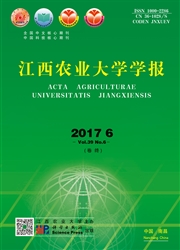

 中文摘要:
中文摘要:
旨在探讨蛋白能量营养充分满足条件下,三江源区2岁高原型放牧牦牛的增重和繁殖潜力,为当地牦牛的研究和科学饲养提供基础数据。试验于2014年6月6日—2014年10月6日在三江源区腹地青海省玉树藏族自治州称多县歇武镇牧业村三社选取2岁牦牛共30头。其中试验组20头,公母各半,初始平均体质量为(81.12±8.57)kg,归牧后自由采食精料补充料;对照组10头,公母各半,初始平均体质量为(78.75±9.58)kg,按照当地饲养方式只放牧不补饲。试验开始前试验组与对照组牦牛初始体质量t检验差异不显著(P〉0.05)。试验用牛每40 d左右称重、采血1次,并记录母牦牛的发情情况。结果:1至2014年7月14日、8月27日和10月6时,试验组牦牛的平均体质量分别达到(109.65±9.48)kg、(139.47±11.26)kg和(156.91±11.46)kg,而对照组牦牛的体质量分别为(89.85±11.51)kg、(110.90±12.78)kg和(118.65±10.58)kg,试验组各时期体质量均极显著(P〈0.01)高于对照组;2截止2014年10月6日最后1次称重,试验组10头母牛共有7头发情,发情率为70%,对照组5头母牛无发情现象,发情率为0,大群调查发现,在传统饲喂方式下2岁母牦牛的发情率为4%。320项血清生化指标分析发现,除7月14日试验组的碱性磷酸酶显著(P〈0.05)高于对照组、血清磷极显著(P〈0.01)高于对照组,8月27日试验组谷草转氨酶显著(P〈0.05)低于对照组、血清钠显著(P〈0.05)高于对照组外,其他指标均差异不显著。4暖季补饲有明显的经济效益。结论:三江源区2岁高原型放牧牦牛有快速增重的潜力,营养是重要的限制因素,暖季补饲精料有助于其增重和繁殖潜力的发挥。
 英文摘要:
英文摘要:
This experiment was to explore the weight gain and reproducing potential of plateau grazing yak under the condition that protein and energy nutrition could fully meet its demand,to provide basic data for re-search and scientific breeding of yak in Three-river Source region.30 yaks were selected from the third club of husbandry village of the Xiewu Town of Tibetan Autonomous Prefecture of Qinghai Province on June 6,2014. The treatment group had 20 yaks constituted of half male and half female,which fed themselves with concen-trate freely after grazing,and their initial weight was 81.12±8.57 kg.The control group had 10 yaks whose sex ratio was the same as that of the experiment group,which only grazed without supplementary feeding concen-trate,and their initial weight was 78.75±9.58 kg.The test did not show significant difference( P〉0.05) in the initial weight between the treatment group and the control group.The result were as follows.①The average weights of the experiment group yaks were 109.65±9.48 kg,139.47±11.26 kg and 156.91±11.46 kg on July 14,August 27 and October 6,2014,respectively.However,the average weights of the control group yaks were only 89.85±11.51 kg,110.90±12.78 kg and 118.65±10.58 kg,respectively.And the treatment group yaks were significantly heavier than the control group yaks(P〈0.01).② On October 6,2014,7 male yaks of the treat-ment group showed oestrous behavior,accounting for 70 percent,but 0 yak in the control group was in oestrus and 4 percent of the yaks under traditional feeding condition would be in oestrus.③Serum biochemical index analysis found that alkaline phosphatase of the treatment group was significantly( P〈0.05) higher than that of the control group,and serum phosphorus was also significantly(P〈0.01) higher than that of the control group on July 14,2014.However,the aspertate aminotransferase of the experimental group was significantly( P〈0.05) lower than that of the control group and serum sodium was significantly( P〈0.05) hig
 同期刊论文项目
同期刊论文项目
 同项目期刊论文
同项目期刊论文
 期刊信息
期刊信息
